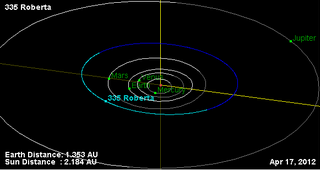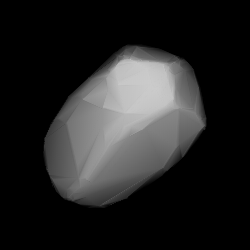1373 Cincinnati, provisional designation 1935 QN, is an asteroid in a comet-like orbit from the Cybele region, located at the outermost rim of the asteroid belt, approximately 20 kilometers in diameter. It was the only asteroid discovery made by famous American astronomer Edwin Hubble, while observing distant galaxies at Mount Wilson Observatory in California on 30 August 1935. The rather spherical X-type asteroid has a rotation period of 5.3 hours. It was named for the Cincinnati Observatory.

Roberta is a large main belt asteroid. It was discovered on 1 September 1892, by German astronomer Anton Staus at Heidelberg Observatory. Roberta was the 12th asteroid that was discovered using photography, and the only asteroid discovery made by Staus.

Ducrosa is a typical Main belt asteroid. It was discovered by Auguste Charlois on 15 March 1895 in Nice.

Edburga is a typical Main belt asteroid. Max Wolf discovered it on 7 January 1896 at Heidelberg Observatory. The origin of the name is unknown. This asteroid is orbiting the Sun at a distance of 2.58 AU with a period of 4.15 yr and an eccentricity of 0.34. Its orbital plane is inclined at an angle of 18.7° to the plane of the ecliptic.

699 Hela is a Mars crossing asteroid. It was discovered on 5 June 1910 at Heidelberg by German astronomer Joseph Helffrich, and may have been named after Hel, the Norse ruler of the underworld. This asteroid is orbiting the Sun at a distance of 2.61 AU with a period of 4.22 years and an eccentricity of 0.41. The orbital plane is inclined at an angle of 15.3° to the plane of the ecliptic.
766 Moguntia is a minor planet orbiting the Sun. It was discovered on 29 September 1913 at Heidelberg by German astronomer Franz Kaiser, and is named after Mainz, ancient Moguntiacum. This object is a member of the same dynamic asteroid group as 221 Eos, the Eos family. It is orbiting at a distance of 3.02 AU from the Sun with a period of 5.24 years and an eccentricity (ovalness) of 0.097. The orbital plane is inclined at an angle of 10.1° to the plane of the ecliptic.
779 Nina is a large background asteroid, approximately 80 kilometers in diameter, located in the central region of the asteroid belt. It was discovered on 25 January 1914, by Russian astronomer Grigory Neujmin(1886-1946) at the Simeiz Observatory on the Crimean peninsula. The metallic X-type asteroid with an intermediate albedo has a rotation period of 11.2 hours. It was named after the discoverer's sister, Nina Neujmina (Tsentilovich) (1889–1971).

810 Atossa is a bright and elongated background asteroid from the region of the Flora family, located in the inner portion of the asteroid belt. It was discovered on 8 September 1915, by German astronomer Max Wolf at the Heidelberg-Königstuhl State Observatory in southern Germany. The presumed S-type asteroid has a rotation period of 4.4 hours and measures approximately 8 kilometers in diameter. It was named after the ancient Persian queen Atossa.
922 Schlutia is a background asteroid from the central regions of the asteroid belt. It was discovered by German astronomer Karl Reinmuth at the Heidelberg Observatory on 18 September 1919. The asteroid with an unknown spectral type has a rotation period of 7.9 hours and measures approximately 18 kilometers in diameter. It was named after Edgar Schlubach and Henry Frederic Tiarks, who sponsored an expedition to observe the solar eclipse of 21 September 1922.

950 Ahrensa, provisional designation 1921 JP, is a stony Phocaea asteroid and slow rotator from the inner regions of the asteroid belt, approximately 15 kilometers in diameter. It was discovered on 1 April 1921, by German astronomer Karl Reinmuth at Heidelberg Observatory in southern Germany.
1657 Roemera, provisional designation 1961 EA, is a stony Phocaea asteroid from the inner regions of the asteroid belt, approximately 8 kilometers in diameter. It was discovered on 6 March 1961, by Swiss astronomer Paul Wild at Zimmerwald Observatory near Bern, Switzerland, and later named after American astronomer Elizabeth Roemer.

1767 Lampland, provisional designation 1962 RJ, is an Eoan asteroid from the outer regions of the asteroid belt, approximately 15 kilometers in diameter. It was discovered on 7 September 1962, by astronomers of the Indiana Asteroid Program at Goethe Link Observatory in Indiana, United States. The asteroid was named after American astronomer Carl Lampland.
1203 Nanna, provisional designation 1931 TA, is a carbonaceous asteroid from the outer region of the asteroid belt, about 35 kilometers in diameter. It was discovered on 5 October 1931, by German astronomer Max Wolf at Heidelberg Observatory in southwest Germany, and named after Anna Risi, a model and mistress of painter Anselm Feuerbach.
1115 Sabauda is a carbonaceous Meliboean asteroid from the outer region of the asteroid belt, approximately 68 kilometers in diameter. Discovered in 1928 by Italian astronomer Luigi Volta, it was assigned the provisional designation 1928 XC. The asteroid was probably named after the House of Savoy, the former rulers of Italy.
1817 Katanga, provisional designation 1939 MB, is a stony Phocaea asteroid in from the inner regions of the asteroid belt, approximately 16 kilometers in diameter. It was discovered on 20 June 1939, by English-born South African astronomer Cyril Jackson at Johannesburg Observatory in South Africa. It is named for the Katanga Province.
1951 Lick, provisional designation 1949 OA, is a rare-type asteroid and Mars-crosser, approximately 5.6 kilometers in diameter. It was discovered on 26 July 1949, by American astronomer Carl Wirtanen at Lick Observatory on the summit of Mount Hamilton, California, and named for American philanthropist James Lick.
2131 Mayall is an inner main-belt asteroid discovered on September 3, 1975, by Arnold Klemola at the Lick Observatory and named in honor of Nicholas U. Mayall (1906–1993), director of the Kitt Peak National Observatory during 1960–1971, who also worked at Lick for many years. It is about 8 km in diameter.

3169 Ostro, provisional designation 1981 LA, is a Hungaria family asteroid from the innermost regions of the asteroid belt, approximately 5 kilometers in diameter.
1235 Schorria, is a Hungaria asteroid, sizable Mars-crosser, and exceptionally slow rotator from the inner region of the asteroid belt. The carbonaceous C-type asteroid has an outstandingly long rotation period of 1265 hours and measures approximately 5.5 kilometers kilometers in diameter. It was discovered by Karl Reinmuth at Heidelberg Observatory in southwest Germany on 18 October 1931, and named after German astronomer Richard Schorr (1867–1951).

1719 Jens is a background asteroid from the central region of the asteroid belt, approximately 19 kilometers in diameter. It was discovered on 17 February 1950, by German astronomer Karl Reinmuth at Heidelberg Observatory in southern Germany. It was named after a grandson of the discoverer.









